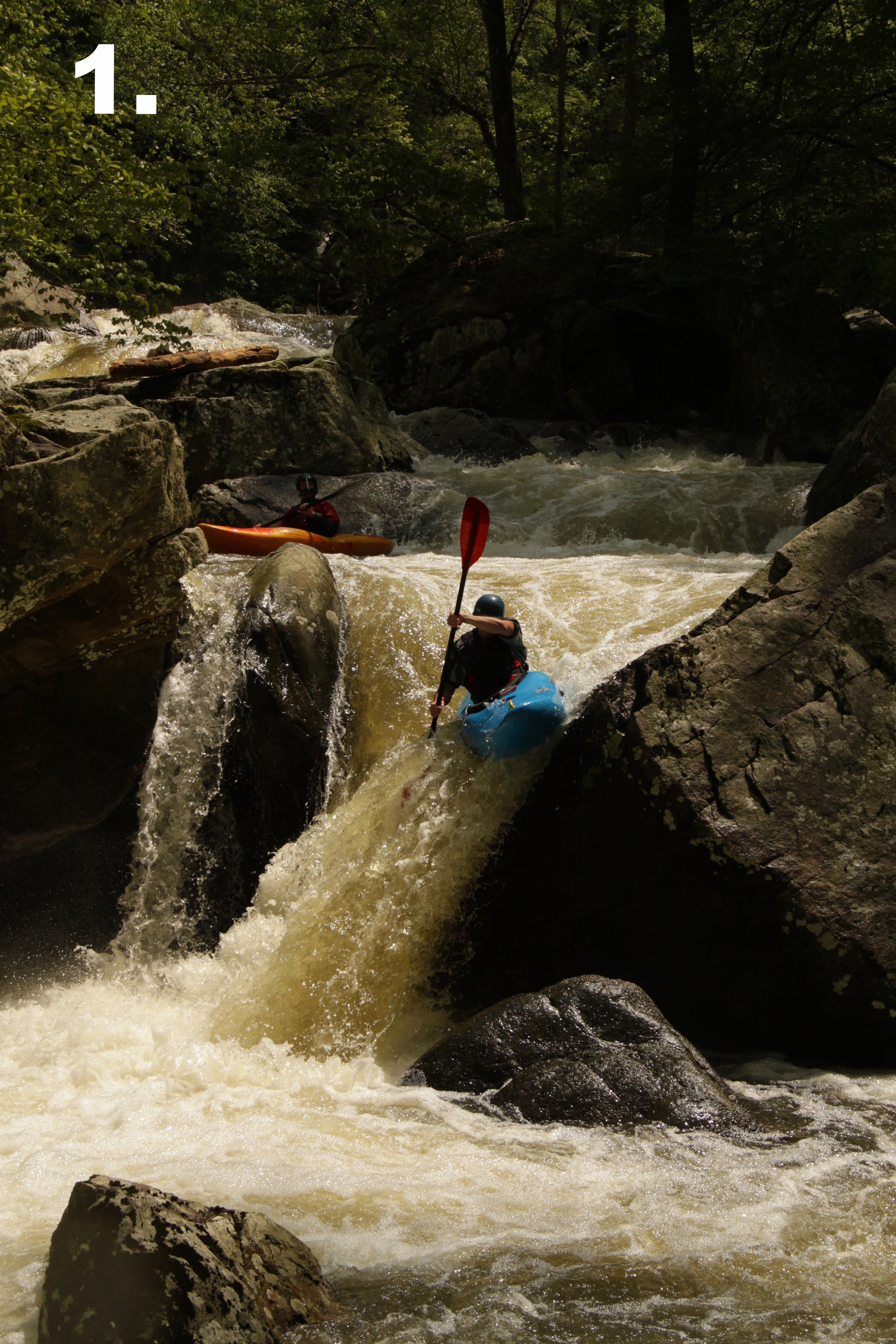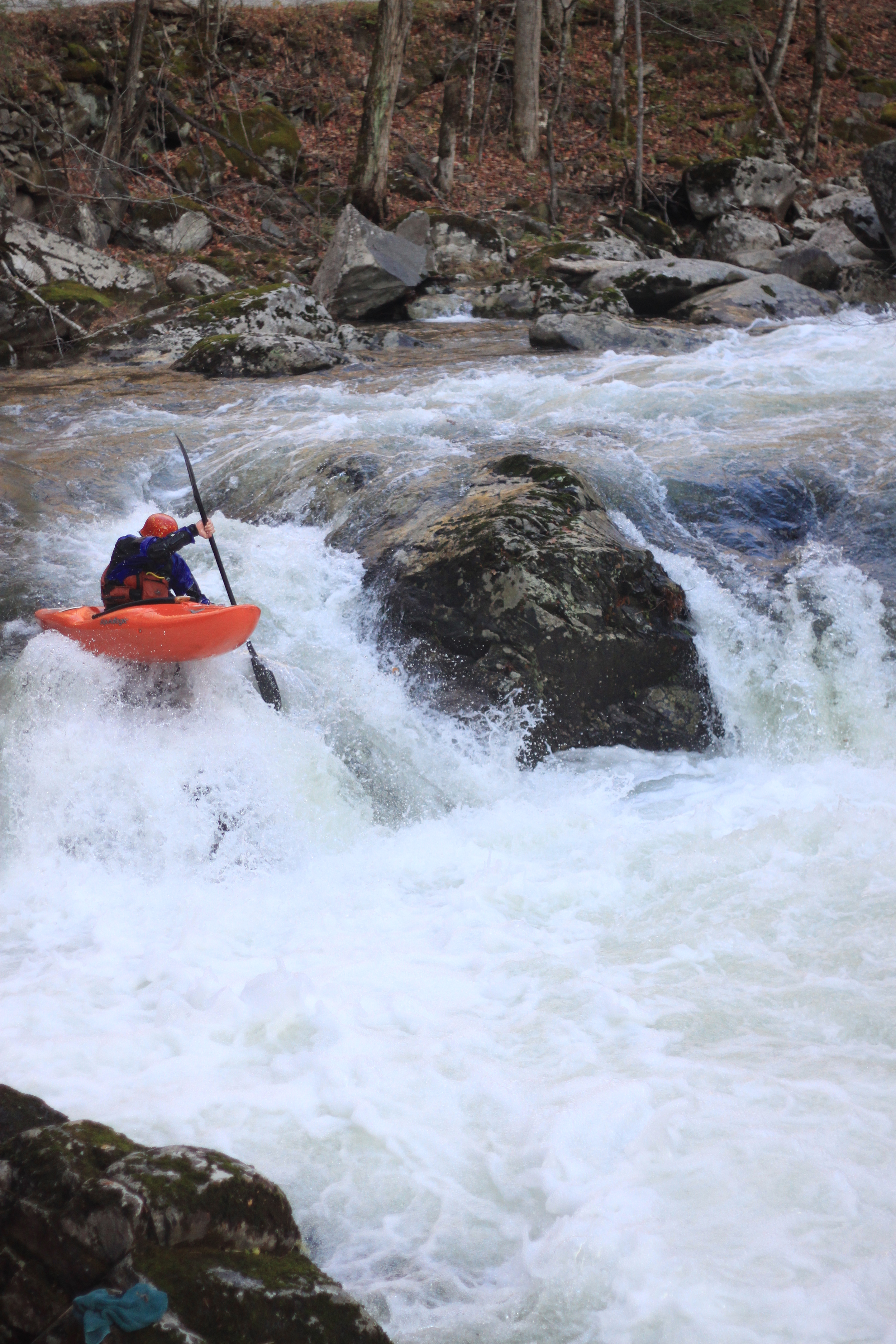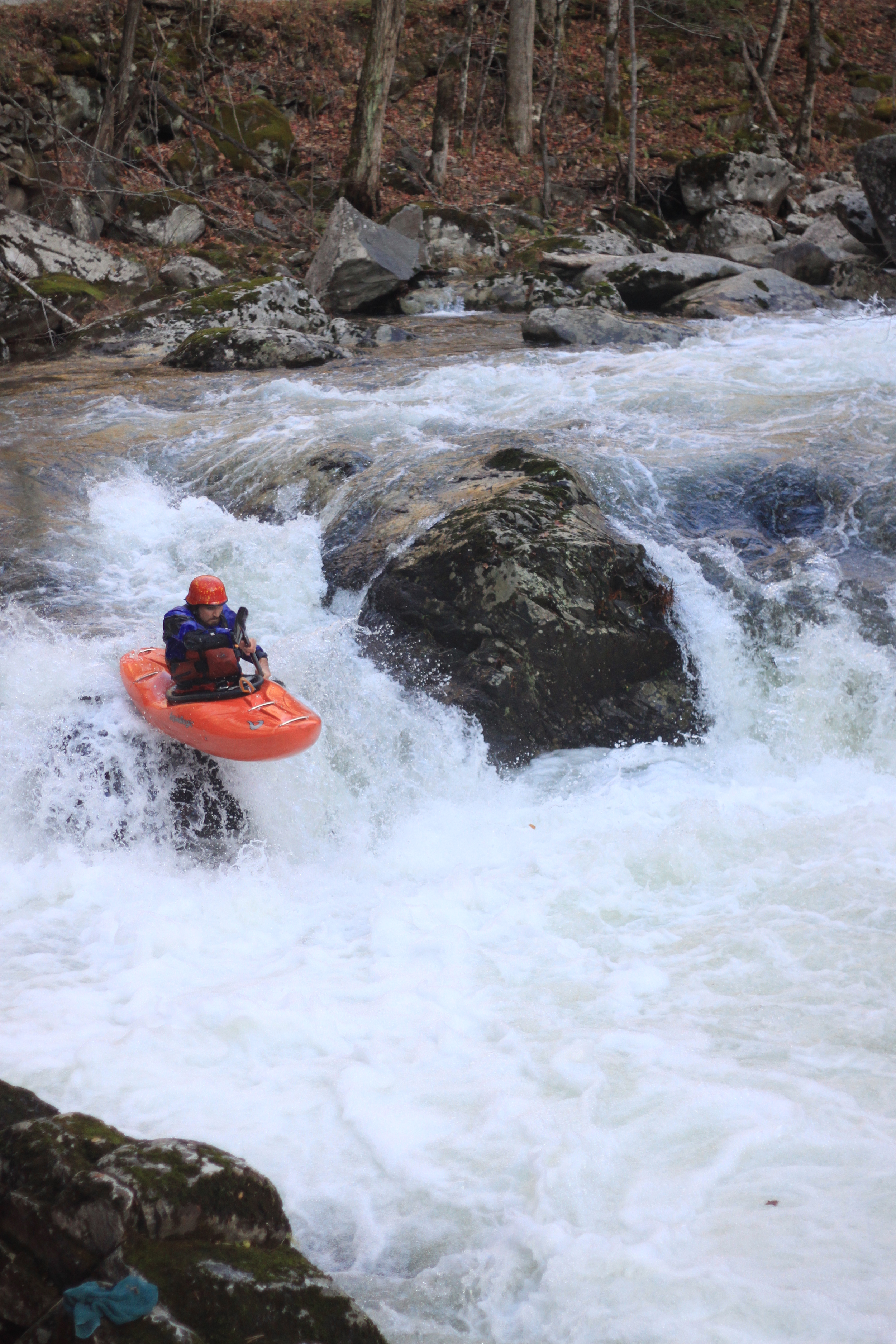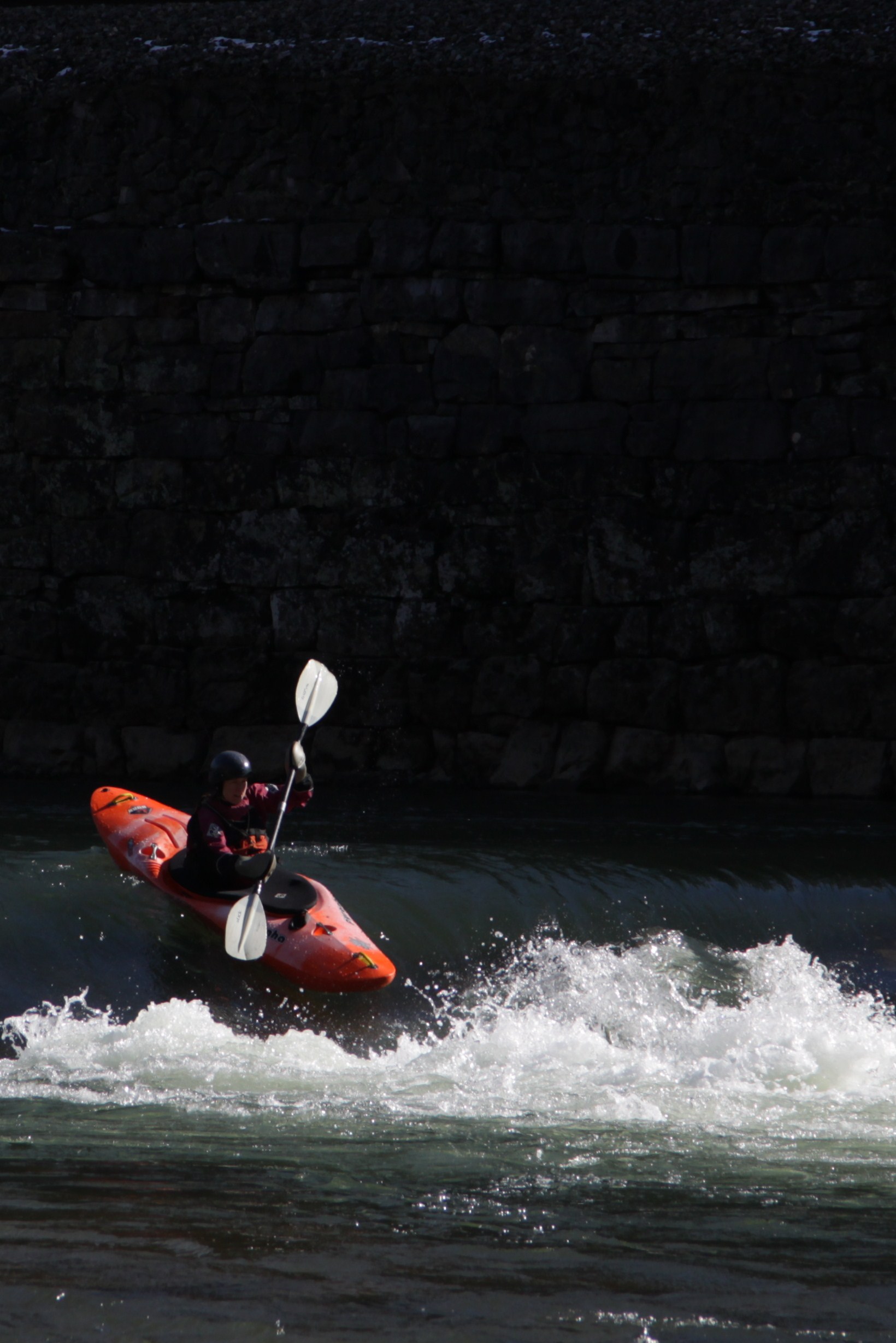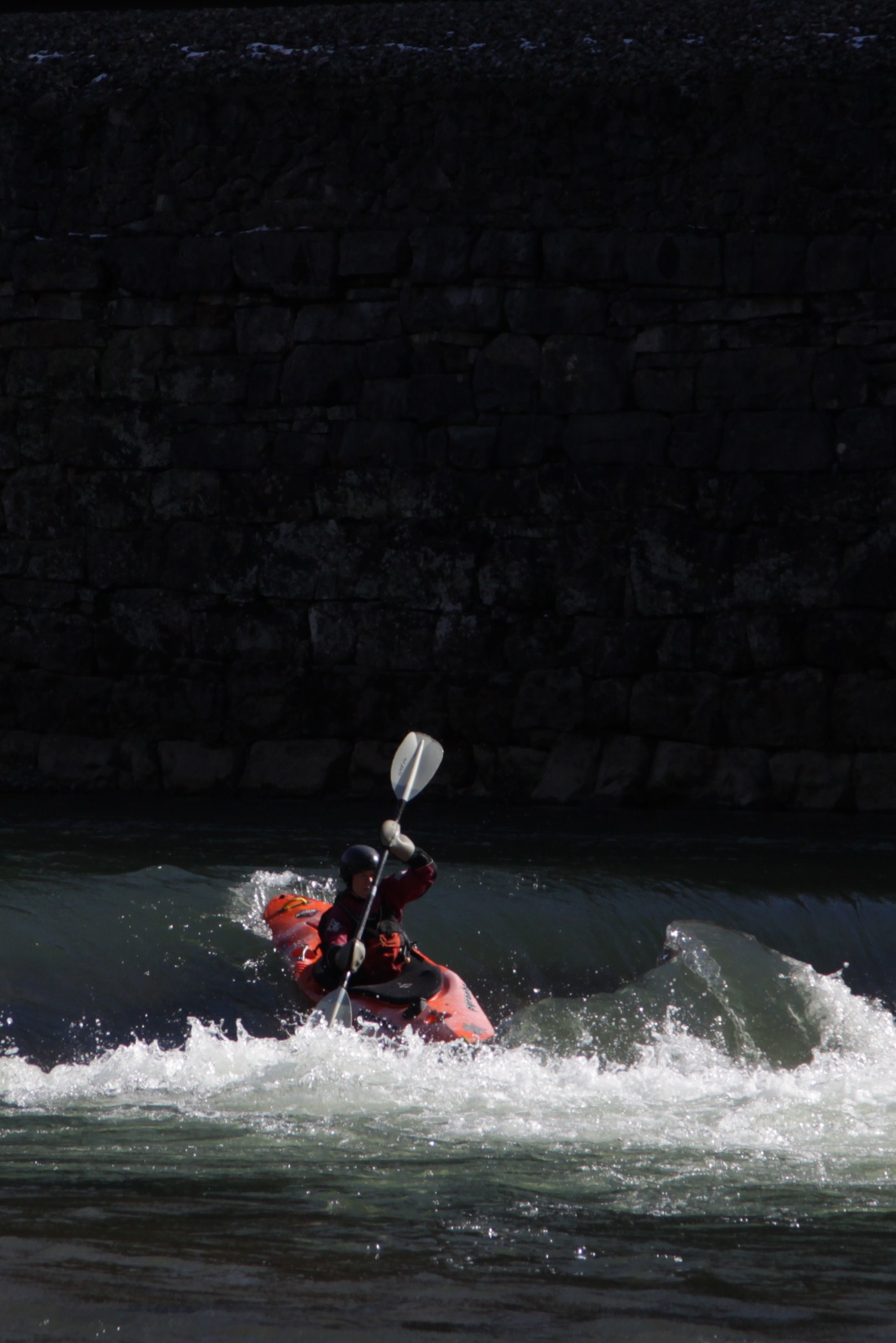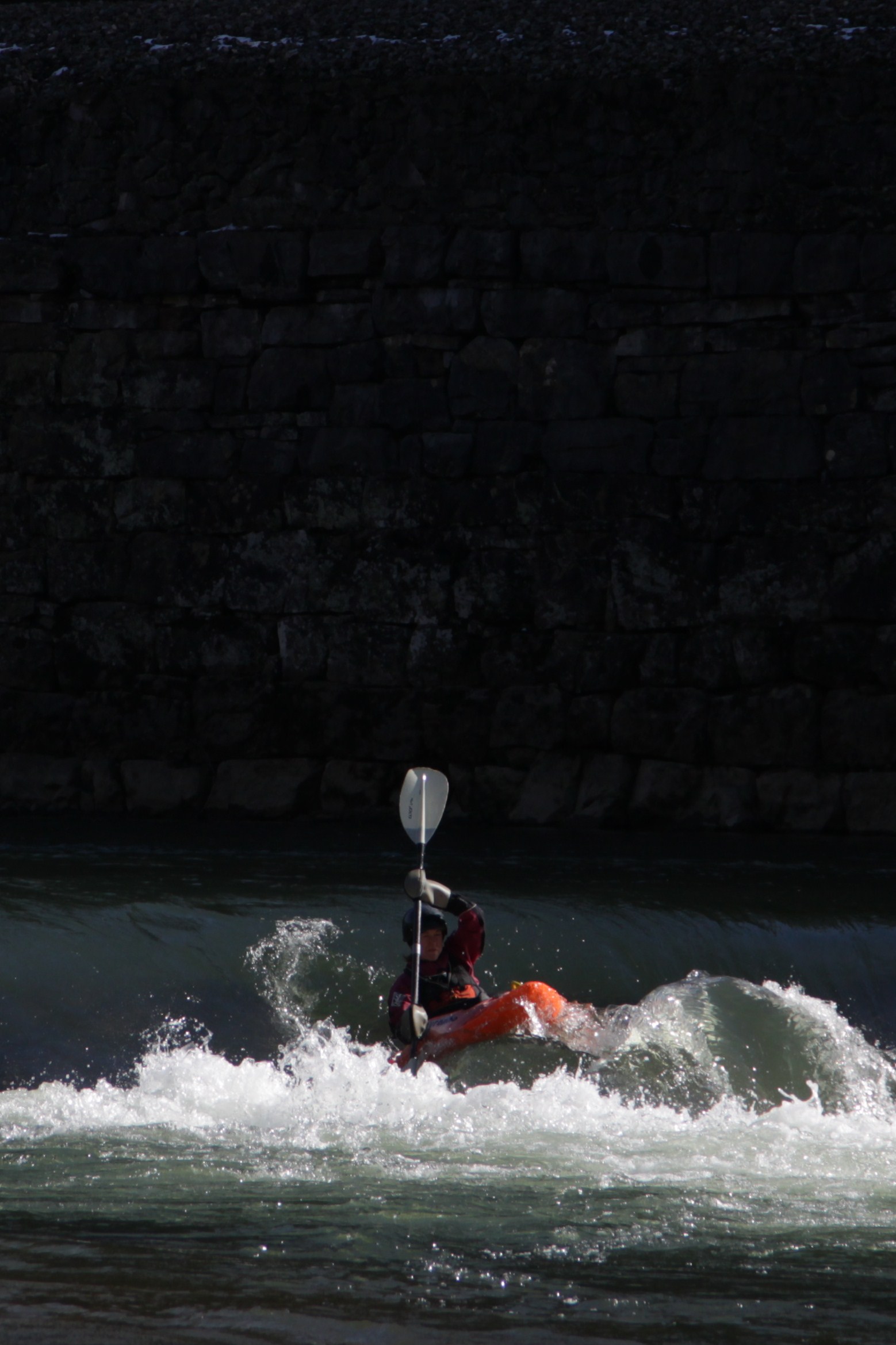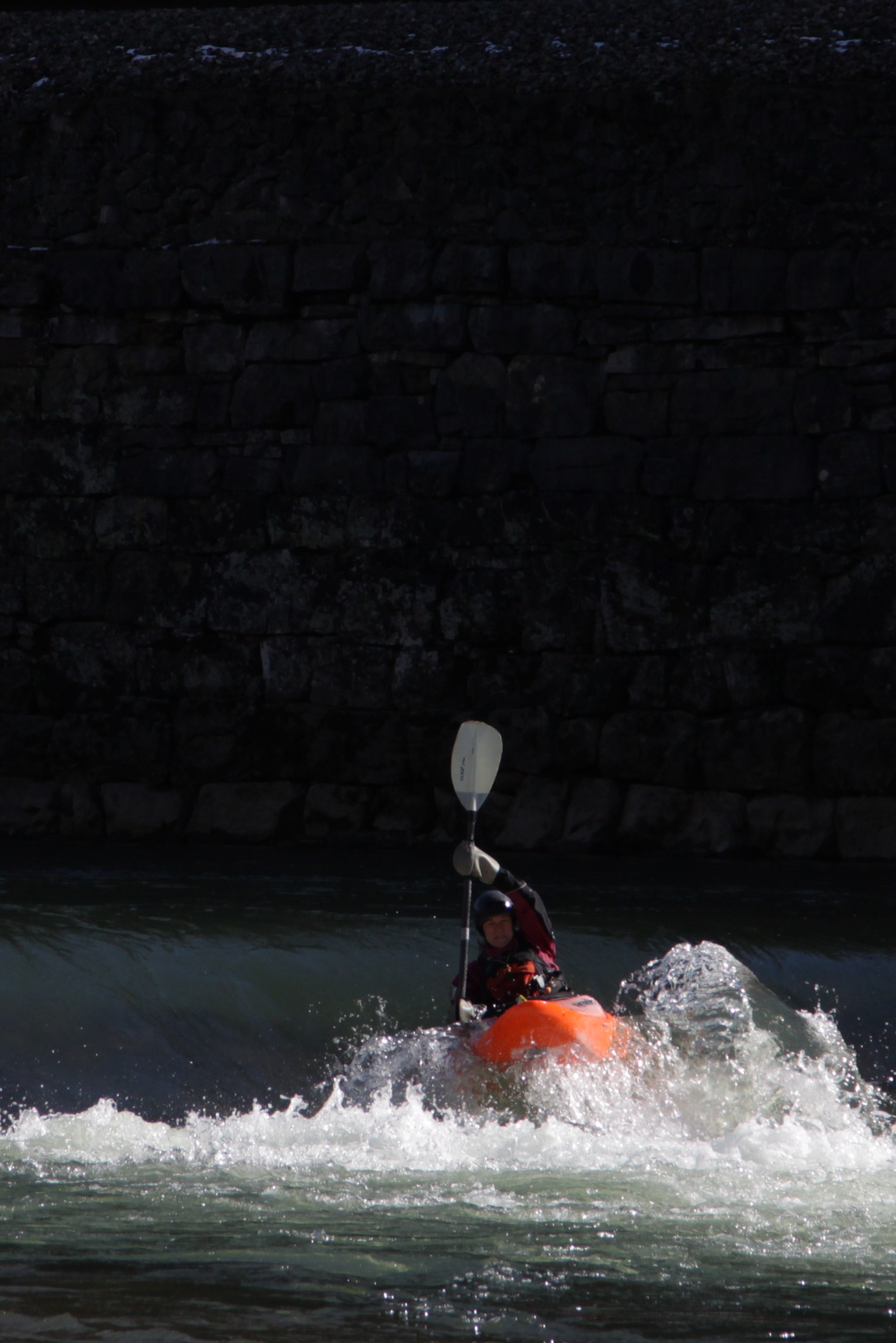Caleb Paquette using deflection from a rock to generate lift - shot by Jim Janney
Deflection - Using River Features to Lift the Bow
When we use deflection to generate lift, we are taking advantage of shapes, features, and directional changes found on the river to give our boat lift. Rocks, logs, diagonal waves/holes, curlers, pillows, and other features have the innate potential to deflect our momentum into a new direction. Deflection can occur in any direction, but for the purpose of generating lift, a feature typically is either going to deflect our boat to one side or the other, or directly upwards. Many features only provide the potential for deflection in one direction - often to one side or the other. Others though, such as a rounded rock with a thin veil of water flowing over the middle and more water flowing off to both sides, exhibits all directions of deflection, which luckily allows us to choose which part of the feature to use. Which direction of deflection we choose to use is often a function of where we want to be going below the feature.
Identifying Deflective Features
Develop the habit of identifying deflective features on the river - it's one of the key steps in finding an optimum line through a rapid. Try to identify the deflective feature (water, rock, or both) and the direction of deflection (river-right, river-left, or upwards) in the following shots, and see how your answers stack up with mine:
Answers
water + rock deflecting to river-right
rock deflecting upwards
rock deflecting to river-left
water deflecting to river-left
rock deflecting to river-right
water + rock deflecting to river-left
water deflecting upwards
water deflecting to river-left
water deflecting to river-left
How to Transform Deflection into Lift
Deflection on its own is a raw, uncontrolled energy that, unless properly routed, will not only prove useless, but actually threaten our line and our stability. So how do we tap into the benefits of deflection? Let's understand deflections as the turns that they actually are. A deflection, whether rock or water, is a point at which the flow is changing direction. If the water hits the feature and deflects to the right, then essentially you have a right turn, vice-versa on the left. There are a few key principles to make sure we cover if we're to take advantage of deflection. Luckily they should be familiar to most paddlers, as since deflections are turns, we approach them in the same way we would approach an eddy-turn. The four things you'll need to channel deflection to your advantage are:
SPEED - Speed gives us stability and control through engaging our edges, and increases the energy potential of our encounter with a deflective feature.
ANGLE - Angling as squarely as possible towards the grain of the deflection will help maximize the energy we harness from the deflection (up to 90 degrees when appropriate).
EDGE - Looking with our body to the inside of the turn when we hit the deflection allows our hull to slide high onto the deflection and then harness the deflection's energy. Note that we don't need to edge directly. Edge is merely the product of rotating our bodies into the turn. Looking with our body is enough!
STROKE - A stroke on the inside of the turn allows us to meter/limit the effect of the deflection and re-route its energy in an upward direction, thus lifting the bow. The stroke and the deflection almost always should be timed to occur simultaneously for the best control.
Let's dissect some case studies in boof. In both of these sequences of shots, I have drawn lines that indicate the grain and flow direction of the water. I have drawn a thicker line with arrow marks that indicates the deflective feature as well as the direction of deflection.
First we've got a nice sequence of Mike Patterson boofing over the nasty hole at Body Snatcher in the Doe River Gorge.
Case Study #1 - The Body Snatcher!
Note that Mike is in the water that is heading to the center of the channel from river-right. He has added his own speed on top of the water's speed, and is angled almost 90 degrees into the deflection. Squaring up the deflection ensures that he will milk the maximal amount of energy out of the deflection and into his hull. He's got the first two ingredients required - angle and speed! In this shot he's focusing on his approach, and ready to time his next move - looking into the turn with his chest and stroking on the inside of the turn.
In this shot, Mike is a split-second from hitting the deflective feature (in this case a curler) and will be re-directed to river-right. If he does nothing, the curler will hit his deck and try to roll him to the outside of the turn. However, he'll treat it the same as he would any right turn, by looking to the inside of the turn with his torso, which raises his outside knee and drops his inside edge. This will expose his hull to the curler, which will then absorb the curler's energy. Also, because he is on edge, his stroke will be able to lift his bow more effectively. So, immediately after this shot was taken, Mike looked to the inside and placed a stroke on the inside.
With angle, speed, and edge, we are set up to maximize the energy of the turn, and harness it with our hull, not our deck. But what's to stop the deflection from pushing us too far? How do we limit the deflection based on our goal, and also create lift? We do this with the fourth crucial element - a stroke on the inside of the turn. Any type of power stroke - forward, sweep, or stern-draw, will limit the ability of a deflection to turn us. It helps us straighten the turn. Think of the placement of a power-stroke as an equal force applied opposite the deflective force. Though the curler in this case is pushing Mike's bow to the right, his stroke is pushing his bow to the left. This combination of forces does two things:
1. It limits the degree of lateral deflection to the desired amount.
2. Through book-ending all of the energy between the deflection and the stroke, the energy has nowhere to go but up - Lift is generated!
Note: Technically, two opposing forces of purely horizontal direction can produce no vertical force (lift). But remember that the stroke is taken while our boat is on edge. That means that the stroke has a vertical component of force as well as horizontal, which in addition to the deflective force, will produce some amount of vertical force. Remember that the amount of lift we are generating is small and quick to fade. We're relying on timing to milk the most of that lift.
Here's a diagram that might make some sense of the different forces at play, and how they can produce lift in the bow:
This force diagram is a very rough representation/oversimplification, but illustrates the idea behind adding a stroke to deflection in order to generate lift. I'd love some input from any physicist kayakers out there!
photo by Kevin Hancock
Let's look at another example. Here we have Caleb Paquette boofing twice through a difficult rapid on Rutherford Creek in British Columbia.
Case Study #2 - Double Lefties!
Here, Caleb has driven towards river-right from behind the boulder and into a curler that is deflecting back towards river-left. So we've got a left turn. Here we catch the moment of truth, where the deflective energy is being absorbed by Caleb's hull and re-purposed into lift. He came in with speed and angle. He looked into the turn and edged aggressively, which allowed his hull to receive the deflection, not his deck. At that same time, he's put in a powerful stroke on the inside of the turn that counters the left-ward deflection. Not only does the stroke push his bow to the right, against the deflection, but his edge, or camber, ensures that some of that force will lift the bow as well, as the hull is climbing up the side of the curler. So how did it work for Caleb?
Stellar! Look at that detachment!
However this is not a single-move rapid. Caleb has work to do just below, as there's another hole that he needs to lift over in order to carry his momentum further downstream. This requires him to have a new angle and speed, and to use a new deflective feature. As Caleb lands the first drop, he will switch his edging to carry momentum back to the right again, for the next left-ward deflection!
Lined up once again! Caleb has speed, angle, and is getting ready to, as his bow hits the deflection, rotate to the inside, edge, and take a stroke to channel the deflective energy upwards.
Here we see that the deflective curler has already redirected Caleb's hull, and he is limiting and controlling the deflection by hanging on his stroke. The water he'll land in is pushing hard back to the right, but he'll keep his angle towards the left - there's a river-wide strainer just downstream! So deflection allows us to lift our bow, but we have a choice of how much of the turn to take. Compared to the first boof, Caleb takes more of the turn here instead of continuing straight, because of circumstances downstream.
Rock Deflection vs. Water Deflection
What about the difference between rocks and water? How are their deflective forces different and how should we adjust our plan accordingly?
For the most part, our strategy for channeling the deflective forces of rock and water into the vertical direction are the same. We approach with speed and angle towards the deflection. We then look into the turn and stroke on the inside to control deflection and re-channel for lift.
There are some notable differences between these two types of deflective features though. Water's shape is dynamic. The features it supports surge and writhe with seemingly chaotic, polyrhythmic oscillations. Water can be pushed aside, or can push back more strongly than expected at any given moment. Due to water's dynamic, mushy nature, the window of time that our boat is being actively deflected by the feature tends to last for a longer duration than with the same shape we would see that was made of rock. This is because the energy transfer occurs over a longer period of time with water. When we hit a curler with angle and speed, there is usually a little bit of give where the water rebounds away from the impact zone before pushing back - that buys us a little room for error on our edge/stroke timing. In a sense, the deflection from a water feature takes a second to load, ramp up to maximum energy, and then subside.
Rock on the other hand, is for the most part, completely static. It's shape is solid, and is unlikely to flex, fragment, or be brushed aside from the momentum our boats carry. Energy travels faster through rock, and is more concentrated. There is less energy loss since our hull can't displace rock and splash it to the side. This tends to cause the redirection of our momentum to be more abrupt or harsh, which has a distinct effect on the character of our deflective experience. Think of comparing how a basketball bounces on concrete as opposed to a swimming pool. Rocks reduce the room for error on our timing, and deflection is experienced in more of an on/off way. There is no ramping up to maximum deflection as with our dynamic interactions with water; instead the split-second your boat hits the rock, a harsh, ballistic-like rebound occurs. This means it's critical to time our edging and stroke correctly for the exact moment we hit the rock, as the full deflective force will play out instantly.
While this may seem to make working with rock deflections more touch and go, there is one caveat about rock deflections that seem to speak to the masses. They are commonly the easiest types of deflections for less experienced paddlers to identify. They're just easier to spot, and it's fairly straight-forward to visualize the direction and intensity of deflection. Before a paddler learns to read water, their eyes really only see two things - rocks, and water. For this reason, rock boofs seem to stick out to novice boofers, as their ability to differentiate one piece of water from the next, which is key for water-boofing, is not developed. Starting with rocks is how most everyone does it, but once water-reading skills improve to where a paddler can start to identify turns and deflection in the water, mastering the lift with water is the next step.
What About Upward Deflection?
Here I'm getting deflected straight up, with little redirection to the side - photo by Jeff Moore
All the examples we've described thus far have focused on side to side deflection, which we have to redirect in order to generate lift. At the beginning of the article though, note that I mentioned upward lift too. Both water and rock can create deflective features that focus most of the energy straight up from the get go. With these features we can spend less of our effort on limiting the side to side deflection and rerouting it upward, and really just dial in our approach (speed & angle). The photo above is a great example of upward deflection generated from a rock. This drop on the Upper Rocky Broad has a sliding bedrock approach with a kicker at the lip of the drop. Hitting the middle of this flake of rock that juts up guarantees what is often called an "auto-boof." An auto-boof has come about to describe any boof that is a guaranteed success, irregardless of boofing skills. Auto-boofs are almost always associated with upward deflective rocks. These are the easiest boofs to hit, as we really only need speed and angle, the first part of the lift equation, to make them work. The timing of aggressive edging and counter-stroking is unnecessary to produce results, so these boofs are favorites among the majority of paddlers. Examples in the Southeast would be:
Middle Ledge, Upper Tellico
Tanner's Boof, Tallulah Gorge
Groove Tube, Middle Line, Green Narrows
These drops are too much fun, and will allow any paddler to get a feeling for the sensation of launching a sweet boof. Other than lining them up though, there's not much else to it. Neither of these drops require a stroke if lined up correctly. These drops are great locales to practice The Stomp, a finishing technique for boofs, since the other portion of the process is somewhat automatic.
Remember that every drop is unique, so even while the cleanest upward deflective rocks may not require a stroke, using a stroke still might be helpful. Most upward deflective rocks introduce a potentially perceptible amount of redirection to the side, so having a stroke to counter might be a safe call.
To accentuate an auto-boof, or "pop-up boof" as they are also called, one can shift their weight forward slightly at the moment of contact in order to put the maximum amount of force into the rock, which will increase the lift. Note that in order to move your weight forward, it can't ALREADY be forward prior to contact with the rock! Sit up straight, shoulders-back/chest-out in your approach, and only as you contact the rock will you thrust your upper body forward. Resist the urge to simply lever your upper body down onto the deck; instead, push your chest forward and keep your posture. The two shot sequence below illustrates this nicely.
The rapid shown above is on Upper Tremont in the Smokies, and is called "The Tooth." In the first shot, Nick Barron is in the exact moment of impacting the feature that gives the rapid its name, an upward jutting kicker at the end of a bedrock ramp. You can see Nick thrusting his weight forward while still sitting up with good posture. Now this kicker does kick slightly to river-left, so Nick has put in a stroke on that side to keep the side-to-side deflection to a minimum. The stroke really isn't generating lift as much as it is maintaining his downstream angle. In the second shot you can see Nick savoring his well earned auto-boof!
So upward deflective rocks make for auto-boofs, but what about upward deflective features made of water? Take a look at the sequence below and note the upward deflective feature in the middle of the ledge.
Here Laura Eddlemon comes in with speed and angle, and the water does most of the work of lifting her. However, without any action on her part, her bow would simply fall with the backside of the uplift and pencil into the water. Here she uses a stroke to prolong the lift that the water has given her so that she can skip through the water below the drop and carry momentum downstream.
Take a second look at the deflective feature. It's really just a wave, isn't it. So we can boof waves? Yes. Yes, we can.
Here's the rub on boofing waves: If there's a feature like a curler on the wave, that is deflecting to the side, it is essentially a turn, and we have a feature that creates an opposite force to our stroke, and the combination of these forces through the lift equation gives us a loud pancake into the trough of the next wave, right? But what if there's no side to side deflection on a wave? Without some type of feature pushing against your stroke, won't your boof stroke simply turn your boat to the side at the crest of the wave instead of lifting the bow and maintaining your angle?
Maybe the solution to this is to get some edge for that stroke. You can see Laura doing that in the image above. Engaging the edge on the side of her stroke should help the boat track and resist the urge to simply slide when she pulls on her stroke. You'll note she also has her stroke vertical and keeps the blade close to the boat. This minimizes yaw (veer) and let's the power of her stroke propel her forward. All these things are nice, but is a slight edge and a proper forward stroke enough to resist spinning the boat?
There's something more profound that Laura did, and it's in her approach. Note in the first shot that she is angled towards river-left, but in the last she is pointed straight at the camera. Laura intentionally came into the wave angled left, instead of squared up to it. She then moved into her forward stroke position by slicing up to the bow with a draw. This draw initiated a turn back to the center to square up the feature just when her bow was reaching the peak of the wave. And her stroke generated lift. Her stroke generated lift on top of what the wave had already given her, without deflection from the side, and without a "kicker" just under the surface.
How can you generate lift without deflection???
CAN you generate lift without deflection?
If you could, wouldn't that mean you could do it anywhere?
Yes, it would.
Stay tuned, and we'll break into the magical world of creating lift through using the powerful combination of spin-momentum and leverage!
Cheers,
Kirk


